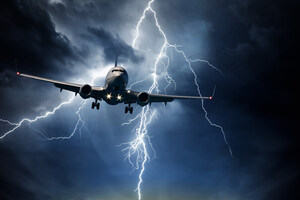Weathering the storm - Artemis Aerospace discusses how aircraft withstand tough weather conditions
WISTON, England, June 29, 2022 /PRNewswire/ -- Every day, aircraft encounter turbulence caused by inclement and unsettled weather. While no pilot will voluntarily fly through a storm, aircraft still need to be able to cope with unpredictable weather-related events. Here, the experts at Artemis Aerospace look at how aircraft are engineered to endure difficult conditions and the skills all pilots need to successfully navigate storms.
Stress testing to the extreme
It's no coincidence that flying is the safest form of long-distance transport. Safety has always been the highest priority for the aviation industry and serious incidents involving aircraft are rare.
The complexity of modern-day aircraft means new planes undergo a series of lengthy and rigorous tests. These tests, which include emulating situations like bird strikes, are constantly evolving to address changes in aircraft design and the potential hazards an aircraft might encounter.
Past incidents caused by technical faults, fatigued fuselage and thunderstorms have also contributed greatly to the development of aircraft engineering and maintenance procedures, triggering major technological advances to ensure similar incidents never occur again.
In addition to the extensive and extreme testing aircraft undergo before they make it into the air, commercial aircraft are also subject to maintenance and visual inspections from engineers and pilots during each flight turnaround as well as undergoing basic maintenance inspections every two days and more thorough inspections every few years. Maintenance, repair and overhaul (MRO) services are an essential element of ensuring aircraft remain safe and ready to fly at all times.
Tackling turbulence
If you've been on an aircraft, then the chances are you have experienced turbulence. While it can be nerve-racking, turbulence, put simply, is an irregular flow of air. Much like the waves of an ocean, which can sometimes be big and erratic, the bumpiness and drops of turbulence aren't necessarily dangerous.
There are three types of turbulence that aircraft encounter: shear (when two adjacent areas of air are moving in different directions), thermal conditions (a clash between warmer and cooler air) or mechanical, caused by a variation in the landscape – for example, flying over a large mountain.
Wings that bend
Wings on modern day passenger jets are extremely bendy, making them highly resistant to turbulence.
To test their resilience, wings are bent to nearly 90 degrees using a specialist rig – far more flex than any aircraft is ever likely to encounter.
Wings and fuselage are also subject to load tests of up to 1.5 times higher than they would be subjected to during a flight.
Snap tests are also performed on wings to determine their breaking point and ensure it is well beyond the predicted level.
Stormy waters
Large amounts of water caused by heavy rain could spell disaster for aircraft. Therefore, aircraft are put through a series of thorough water tests, including having to taxi through specially made water troughs, or forcing a steady stream of water or firing loosely compacted ice into the engines to mimic rain and hail. This enables engineers to establish how the engines, thrust reversers and braking systems will function following water exposure and how this would affect an aircraft having to contend with bad weather.
Wild wind
People from all over the world were captivated by Big Jet TV's coverage of aircraft struggling to land at Heathrow Airport during Storm Eunice.
For passengers and spectators on the ground, strong winds, which cause aircraft to sway back and forth, can seem alarming and feel precarious for those onboard.
Pilots are experts in navigating turbulence and poor weather conditions. Regular flight simulator training sessions mean pilots are well-versed in every type of situation they might encounter during a flight, including stormy weather or landing in windy conditions.
Airlines and airports will also have their own set wind speed limits in place – if the wind is too strong, then aircraft will not be allowed to take-off or land. Indeed, many flights from Heathrow were cancelled during Storm Eunice while others had to perform go-arounds or diversions. Airport operations are strictly regulated to ensure the safety of all passengers and crew.
While there is no single maximum wind limit, as it depends on the direction of wind and phase of the flight, a crosswind (winds perpendicular to the runway) above 40mph and a tailwind of more than 10mph are considered problematic. Limits will also depend on aircraft type, runway direction and general weather conditions.
During the testing phase, aircraft will be subjected to specially made wind tunnels to assess their strength in extreme conditions. For example, Boeing's Test and Evaluation department's tunnel can test speeds between 60 and 250 knots (70 and 290mph). This facility simulates many kinds of rain, ice and cloud conditions that aircraft might come across.
Lightning tests
On average, commercial aircraft are hit by lightning around one to two times per year.
While the high electrical conductivity of aluminium can dissipate the electricity through the aircraft structure quickly without causing damage, not all planes are made from metal anymore.
To reduce weight and fuel consumption, lighter materials are used, such as carbon fibre, which has a much lower electrical conductivity.
To protect such materials from lightning strikes, a thin layer of metal mesh or foil is added. Panels are also put through lightning test strikes to better understand the reaction of different materials.
Website: www.artemisaerospace.com
Sources
https://www.bbc.com/future/article/20140319-stress-tests-for-safer-planes
https://www.metoffice.gov.uk/weather/warnings-and-advice/seasonal-advice/travel/why-does-the-weather-affect-flights
https://www.headforpoints.com/2022/02/18/chaos-at-heathrow-airport-as-storm-eunice-rolls-in/
Photo - https://mma.prnewswire.com/media/1850260/Aircraft_storm.jpg







Share this article